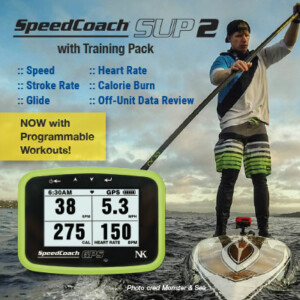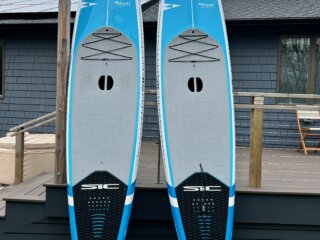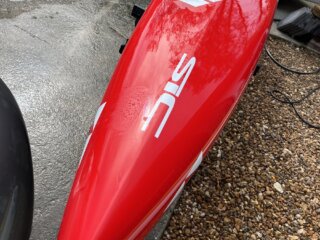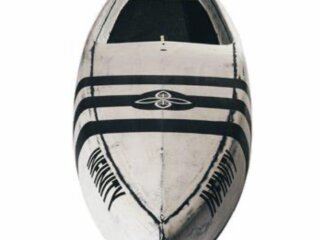
How to Keep Your Gear Safe During Transport
Unless you live on the water or are a member of a club that can store your boat or board at the water for you, you’ve got to cart your craft around on your car. If you paddle an inflatable, you can stash it in the back of your vehicle and inflate it each time you paddle. But if you’re paddling anything else – a hard board, an outrigger, a surf ski or a canoe or kayak – you’ve got to load it on top of the car each time you want to take it to the water. If you’re paddling every day or if you go on long trips to races, you’ll be doing a lot of driving with something on your roof. Your car’s roof racks are something you should pay a lot of attention to.
You want to make sure that whatever type of craft you’re carrying stays on your car while you’re driving. You’re not only concerned about the safety of your craft but also those on the road behind you. If your board or boat flies off the car, it’s almost certain to suffer damage that will require major repair. Worse, if it happens in traffic, it’s almost certain to cause serious issues behind you. Can you imagine driving along and suddenly having to dodge a SUP board that is flying towards you? At high speeds this is a serious accident waiting to happen that can potentially involve multiple vehicles and cause serious injury and even loss of life. And, you, the one that couldn’t keep the load on the roof of your car, are the one that will be held responsible. There’s potentially huge liability issues every time you put your paddle craft on your car.
A couple of summers ago, within a span of just two weeks, I heard of five incidents where paddlers lost their boards while driving. Three of these incidents happened to people I paddle with. Fortunately, nobody was seriously injured and, in one case, the boards on the roof were completely undamaged. Still, it was sobering to hear how easily things can go wrong when you’ve got your board on the roof of your car.
Let’s take a look at two of these incidents in a bit more detail.
Case Scenarios
Case 1 – Dealer installs the wrong rack on a new vehicle
A few days before the Carolina Cup, Kirsty was driving two Starboard All Stars, bagged snuggly in their covers, across the top of Toronto to Glen, who was going to drive them to Wrightsville Beach.
Driving her new SUV, she’d gotten through the heaviest traffic and was on the 407, a high-speed toll highway that crosses the top of the city. Some weather moved in, the wind picked up and it started to pour rain. Suddenly, the roof racks broke free from the rails on the roof of the car and the two boards, still fastened to the cross bars, flew into the air, landing in live lane of traffic behind her.
Fortunately, traffic was light enough that no other vehicles were hit or had to swerve to avoid the boards on the road. Kirsty was able to quickly pull over and race back to pull everything onto the shoulder. Somehow, she managed to stuff everything into the back of her SUV and keep it there long enough to get off the highway at the next exit, where she disassembled the boards from the cross bars. She has able to put the bagged boards back on her car with them sitting directly on the roof and fasten them down using the straps and the roof rails, then drive very slowly the rest of the way to Glen’s.
At Glen’s, they unzipped the board bags to inspect the boards and, surprisingly, there was no damage to either. Not a scratch or a dent.
After delivering the boards, the next step was to figure out what went wrong. As it turns out, the dealer had installed the wrong racks on her new vehicle. The mounts weren’t a correct match for the rails on the car. With the combination of a large load with lots of surface area – like two SUP boards – and highway speeds, it was only a matter of time before the mounts failed and the racks, and their load, flew. (see figures 1 and 2)


Case 2 – Lockrack system fails
Tim lives in Collingwood, Ontario, and splits his training between home and Oakville, Ontario, which is close to where he works as a firefighter. Collingwood and Oakville are about 150 km apart, so he’s regularly putting in lots of highway miles with a board on his truck.
Like many, Tim liked the convenience of the Lockrack system when he first saw it. He bought a set of the racks and enjoyed how fast and easy it was to get his board securely on the truck, especially when it was windy.
Unfortunately, for Tim at least, there was a price to this convenience. While driving home on the highway from Oakville one day, the front lock rack failed, breaking off where it inserts into the base (see figure 3 and 4). Immediately, the board flew. Luckily, there was no traffic behind him. The covered board bounced along the road and ended up on the shoulder without hitting anything.


When he unzipped the cover to inspect the damage if was significant but repairable (see figure 5, 6, 7). The board was out of action for a few weeks for repair.



Your Board Flying is Usually Avoidable
In most instances, including the two examples above, your board flying off the car is usually avoidable. While there is no guarantee that a rack system won’t fail, there are things you can do to minimize the risk of its failure. And, there are certainly things you can do to keep your load on your car even if your racks do fail.
Here’s a list of things you should consider if you want to travel safely with your boat or board on your car:
- Make sure the racks you’re using are properly designed, and fitted, for your vehicle. The easiest way you can do this is to purchase your racks from a rack specialist. They’re experts and can correctly match the rack system and all its components to your vehicle make and model. Furthermore, they can help you install it correctly. This is the most important thing you can do to ensure you’re safely transporting your boat/board whenever it’s on your car. It greatly reduces the risk of the system failing.
- Use the right rack attachments for the craft you’re carrying. Depending on whether you are carrying a SUP board, an OC1, a surf ski, a racing canoe or kayak, or a recreational craft, there are special rack attachments available to provide your craft with the smoothest and safest ride possible. For example, outriggers and surf skis are much longer than SUPs and have a rounded cross-section, not flat. They travel best in some kind of cradle or slings as opposed to on flat racks, while the length ideally requires that the rack contacts and tie down points be further apart than they are for a SUP. Your craft will be more secure and less susceptible to damage if it is secured with a rack attachment that is designed for it.
Once you have selected the appropriate rack attachment to carry your craft, all of the other safety considerations here should apply. Check your set up regularly, inspecting for signs of rust or wear. If the rack attachment fails, not only do you risk losing your craft, but also the rack attachment itself. This can be much, much more dangerous for those following you on the road. Attention to detail with regards to safety can help avert potential disaster.
- Inspect your racks regularly. Racks, like anything else, wear with time. Parts will eventually fatigue or corrode and weaken. It’s unavoidable. This is particularly true if you use them in harsh conditions. For example, if you leave them on your car year-round in a climate with four distinct seasons, they’ll be exposed to scorching heat in the summer and deep sub-zero temperatures in the winter. These conditions can greatly accelerate the rate at which the metal parts in rack mounts fatigue.
Look for signs of rust or corrosion. Regularly pull hard on your racks to make sure they don’t move or that there are no signs of weakness. Take your vehicle and racks to the specialist you purchased the racks from every year for them to inspect them. They’ll be able to tell you whether any parts appear to be wearing to the point where they need replacing.
Stay away from bungee cords. They aren’t that strong and frequently break. If you tie down with bungees alone, you risk losing your load. Furthermore, bungees are dangerous. I’ve seen them break when tying down. A stretched bungee that breaks is going to snap back towards to the end it’s being stretched from, and that is you. Bungees can be incredibly dangerous if they snap back anywhere near your face. Rope can be a more secure option and is much safer than a bungee when you’re tying down. Unfortunately, unless you’re really good with knots (I’m not) you run the risk of the ropes loosening while you’re driving, and that risks you losing your load. Also, if it’s windy and you need to secure your board quickly when tying it down, rope isn’t a great option. It generally takes longer to tie down safely using rope than with other options.
By far the best tie down options are tie down straps designed for roof racks. They’re easy and safe to use and you can get your board secured to your racks quickly on a windy day. Plus, they’re durable and strong, and they’re designed for exactly what you are using them for. You can even get locking straps with steel cables inside, which are not only stronger but will slow down anyone trying to steal your board when you’re not looking.
- Inspect and replace your tie down straps regularly. Tie down straps will wear much more quickly than components of your rack system will. If you see any fraying or other signs of wear, they need replacing immediately. They’re relatively inexpensive and can make the difference between keeping the load on your car or losing it. Getting new straps the moment you see any signs of damage or wear in the ones you’re using is a small price to pay to arrive at your destination with your load safely on your car.
- Use safety straps when traveling long distances or at high speeds. When I am driving only 4 km from home to where I launch at 60 km/h or less, I don’t bother with safety straps. However, when I am driving longer distances or at highway speeds, I always use safety straps.
Safety straps are simply a second set of straps securing your load to your car. How you most effectively use safety straps depends on the rack system you’re using. Let’s take a look at a few different examples:
- Cross bars on rails. If you’re attaching your rack system to roof rails like you frequently see on wagons and SUVs, you should tie your safety strap down to the rails themselves rather than the cross bars. In this way, should the rack system fail, your load is more likely to stay on your car, allowing you to slow down and stop to assess the situation. You’ll likely be able to continue to travel, slowly, to a place where you can get your rack situation taken care of and resume your trip. This is far better than losing your load. In the example provided in case 1 above, Kirsty would have been able to keep her load on her car had she been using a safety strap.
- Cross bars attaching directly to the vehicle. In this case, you’ve got two options on how to use your safety straps. You can simply tie your safety strap down to the cross bars, essentially providing a backup strap should the primary strap fail (but doing nothing to keep your load on the car should the rack system fail). Or, you can run a longer strap around the load and though the car’s cabin. In this case, you’re using your safety strap to keep your entire rack system on the car should it fail. This isn’t going to provide you with a reliable and safe long-term option to continue your trip should your racks fail, but it will keep your load on the car, allowing you to stop and assess the situation.
In the example provided in Case 2 above, Tim would have been able to keep his board on his truck simply by putting a safety strap around the board and trying it down to the cross bars, rather than relying solely on the light metal Lockrack inserts.
For shorter trips, a safety strap at the front tie down point only is enough. You’re much more likely to have a catastrophic loss of your load if it’s the front rack that fails. However, for long-haul highway trips why not use two safety straps? It’s a simple step to take to dramatically limit the chance of anything going wrong over a long trip.
*
Thankfully, most of us will never encounter an issue when driving with a boat or a board on the roof our car, even without taking some of the simple, practical precautions suggested here. But, you are taking your chances if skip these precautions. Racks do fail, and the results can be catastrophic for both your boat/board or for others on the road. It’s only a matter of time until we read about a highway fatality occurring as a result of someone losing their boat/board – a tragedy that is entirely avoidable.
Happy paddling and safe travels with your paddling craft!
Larry
Paddle Events
DeSatnick Foundation Around the Cape Paddle
Ohio River Paddlefest Races
The Circumnavigation-Tilghman Island 2024
Recent Classifieds
2 Boards: Both SIC Bullet 12’6″ x 28.5″
- Sell
- 4 days ago
- Stand Up Paddleboard
- 02813 Charlestown , Rhode Island United States
- 72 views
SIC XRS 14 x 22
- Sell
- 1 week ago
- Stand Up Paddleboard
- Chattanooga , Tennessee United States
- 109 views
Wanted! Ocean / downwind 14 foot SUP
- Buy
- 1 week ago
- Stand Up Paddleboard
- Main Street , 07005 Boonton , New Jersey United States
- 100 views
one edge pro 2.0 hollow 14′ x 23.5”
- Sell
- 1 week ago
- Stand Up Paddleboard
- 53066 Oconomowoc , Wisconsin United States
- 132 views
2021 Starboard Allstar 14×24 5
- Sell
- 1 week ago
- Stand Up Paddleboard
- 21085 Joppatowne , Maryland United States
- 110 views
Subscribe for Premium Content and Coaching
Join the Paddle Monster paid Plan Today!
You May Also Like


The Island Paddler: How (and Why) I Became a Voyager





